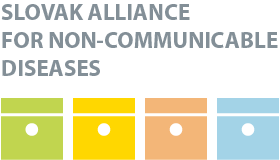—
HPI Network > HPI - Health Policy Institute > Health System in Slovakia > 4. Physical and human resources > 4.1 Physical resources
4.1 Physical resources
Thursday, 05. May 2011, 0:57 — HPI
| << PREVIOUS
4. Physical and human resources |
Introduction – Organization – Financing – Resources – Provision – Reforms – Assessment – Conclusions – Appendices |
NEXT >>
4.2 Human resources |
- 4.1.1 Capital stock and investments
- 4.1.2 Infrastructure
- 4.1.3 Medical equipment
- 4.1.4 Information technology (IT)
4.1.1 Capital stock and investments
In 2008, there were 138 hospitals in Slovakia, 73 of which were general hospitals and 65 specialized hospitals or inpatient facilities (Table 4.1). A study carried out in 2004 found that the technical infrastructure of hospitals is unsatisfactory and old fashioned (see Table 4.2), which leads to their ineffective management (Sanigest International, 2004). The average age of the Slovak hospitals was 34.5 years. In 2004, a hospital site consisted of 30 buildings on average, but some health care facilities owned up to 81 buildings (for example Faculty Hospital in Martin). Capital investments from the Ministry of Health budget were abolished in 2003 to avoid non-transparent decisions. Instead, these budget resources were allocated to health insurance companies to include amortization in their payments to providers. See also section 2.8.6 Regulation of capital investment.
Table 4.1: Number of hospitals

Table 4.2: Technical operating conditions of buildings by hospital categories (%)

4.1.2 Infrastructure
A minimum network of providers is set by government regulation and defines the density and structure of health care providers across Slovakia. In primary care, a GP is entitled to a contract as soon as a patient registers with him or her. In ambulatory secondary care, the minimum network is defined as a minimum number of specialists by type in a given region. The health insurance company may contract more capacity if they have enough resources. In inpatient (“tertiary”) care, the minimum network is defined similarly to secondary care. However, the regulation also explicitly states that certain stateowned hospitals must be contracted, even if quality and price do not match those of their competitors. These state-owned hospitals are deemed crucial in guaranteeing geographical accessibility of specialized services.
In 2007, there were 26 546 acute beds, 4450 psychiatric beds and 4403 long-term beds in Slovakia. All three types of beds have seen a gradual decline in relative and absolute terms since 2000 (see Table 4.3). A bed reduction plan, which was adopted in 2002, provided the basis for adjustments in the structure of both inpatient and outpatient care providers. The total number of acute beds was reduced; 6000 were eliminated or transformed into chronic care beds (which, however, were also reduced). Three acute care hospitals were closed and several others transformed into almost exclusively chronic (long-term) care facilities. In two cases, hospitals were merged and in many cases superfluous buildings were sold. After this reduction, the Ministry of Health still spoke, in 2006, of an excess of 6500 beds in general. In case of extraordinary situations such as crisis situations or pandemics, the Ministry of Health guarantees an increase in production ability of the health sector by increasing the number of beds.
Viewed from a European perspective, in the early 1990s the number of acute beds per 1000 population in Slovakia was one of the highest in Europe, well above the average of the countries that would later form the EU27 (see Fig. 4.1). At the same time, the occupancy rate for acute beds (77.2) was roughly on the EU12 average and slightly above the EU15 average, as shown in Fig. 4.2. Even though the number of acute beds has steadily declined, it was still among the highest in Europe in 2008. The acute bed occupancy rate fell as well – to 67.5 in 2008, which was well below the EU12 average (71.5) and EU15 average (77.2 in 2006). The reductions in the number of beds per 1000 population and occupancy rate can be explained by the active reduction policy mentioned above and simultaneous decline in the average length of stay in acute hospitals (see Fig. 4.3) and gradually decreasing number of admissions (see Table 4.4 – here for all beds combined). Indeed, the strong and almost continual decrease in the average length of stay in acute care hospitals in Slovakia since 1990 has closely followed the trend observed in the new EU Member States. In 2008, patients in Slovakia averaged a 6.9-day stay in acute care hospitals, showing a steep drop from 2007, and falling below the averages of Germany and the Czech Republic. So far, substitution by one-day surgery procedures lags behind, although a dynamic growth of facilities with one-day surgery has been observed in the second half of the 2000s (24 facilities in 2005, 52 facilities in 2006).
Health care facilities are usually closed due to a lack of contracts with health insurance companies and/or as a result of negative financial results. The fact that Slovakia does not have a long-term infrastructure plan has led to imbalances in the number and structure of hospital beds as well as a considerable migration between regions. Approximately every ninth patient is hospitalized in another region than his/her region of residency (Szalay, 2008). Furthermore, the distribution of long-term care beds also reveals significant regional discrepancies.
Table 4.3: Acute, psychiatric and long-term care beds
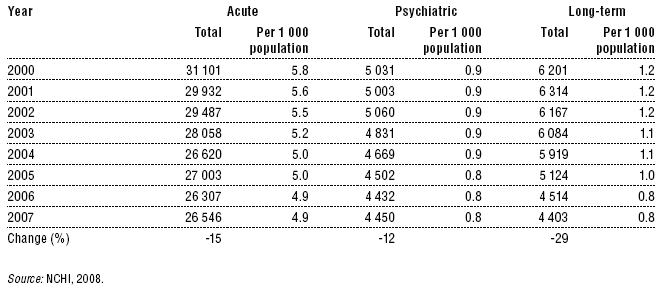
Table 4.4: Utilization of bed capacity

Fig. 4.1: Beds in acute hospitals per 1 000 population in Slovakia and selected countries, 1990 to latest available year

Fig. 4.2: Bed occupancy rates (%) in acute-care hospitals in Slovakia and selected countries, 1990 to latest available year
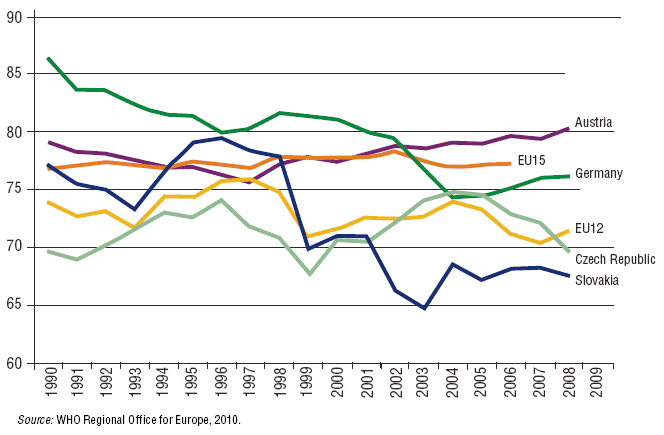
Fig 4.3: Average length of stay in acute-care hospitals in Slovakia and selected countries, 1990 to latest available year
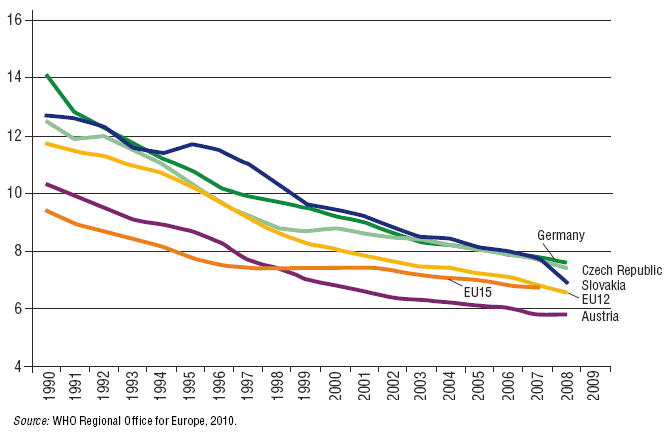
4.1.3 Medical equipment
The purchasing of big-ticket medical equipment and technologies is currently not regulated by legislation. Although health insurance companies are required to guarantee a minimum provider network and bear formal responsibility for the accessibility of health care, ensuring the availability of certain technologies and providers, however, is neither specified nor regulated.
Only radiation technologies are subject to inspection by PHA experts because of radiation protection. In 2007, there were almost 700 X-ray machines in Slovakia (NCHI data). According to health technology experts, only 450 of them were fully operational. The average age of the equipment used in 2008 was 14 years, and a large number of these machines were technically outdated. Only institutions with a strong financial position can adapt to the latest developments in technology. The first X-ray machines capable of digital radiography were purchased in 2004. In 2008, 15 institutions in Slovakia were equipped with such digital X-ray machines.
The first computerized tomography (CT) scanner in Slovakia was put into operation in 1983. In 2008 there were 76 CT scanners in Slovakia, 25% of which were owned by private health care providers. This equals 14 CT scanners per 1 million people.
The first magnetic resonance imaging (MRI) equipment in Slovakia was installed in 1992. In 2008, there were 30 MRI machines (73% in private ownership), or 5.5 MRI machines per 1 million people. There were only two PET systems operational in Slovakia in 2008 – one was in private hands, the other state-owned.
In 2005, the density of CT and MRI scanners in Slovakia, expressed in numbers of machines per million people, was higher than in Hungary and Poland but still well below the EU15 average (see Table 4.5).
Table 4.5: Number of diagnostic imaging technologies per million population, 2005

4.1.4 Information technology (IT)
According to Eurostat data, 37% of households had access to the Internet in 2007. Only 27% of households had a broadband Internet connection at home. These data are comparable with other countries in the region, but well below the EU15 average (see Table 4.6). A Eurostat survey (2007) has indicated that use of the Internet in Slovakia is a generational issue: 79.5% of people aged between 16 and 24 years and 57.5% of people aged between 25 and 54 years use the Internet at least once a week. In contrast, this figure is only 12% for people aged between 55 and 74. The Internet in Slovakia is used by 46 % of households (Eurostat Data in Focus, 2007).
Table 4.6: Households with broadband Internet connections (%)
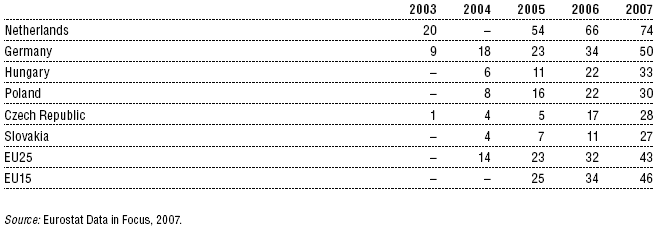
Most of the primary care providers and specialists use information technologies in their practices. Among information technologies, desktop computers prevail, with average hardware age of more than three years. The majority of providers use one of many specialized ambulatory information systems purchased from IT companies. It is not an obligation to have an information system and there are no regulations or standardization requirements laid down in law. Approximately 30% of outpatient departments have Internet access, and the number has been rising. The Internet is used to search for scientific information and to log on to certain information systems (for example, the database of insured). Approximately one-third of all Internet connections in outpatient departments are high-speed Internet connections. The level of IT security is low. Security requirements are not specified by law and providers often use either illegal or incomplete software versions (Ministry of Health, 2007). Although significant progress has been observed in the development of e-health, it is not enough to ensure smooth interoperability of the national information systems and information system of providers. The health information strategy, as elaborated by the Ministry of Health (2008), lacks concrete steps at the level of providers as well as financial specifics (also see section 2.7.2 Information systems).
The use of IT diverges widely in inpatient health care facilities. Most of the hospitals own a hospital information system, consisting of three parts: (1) a hospital care information system, (2) an economic information system and (3) a management information system. Hospital information systems are purchased from various IT companies but not required or regulated by law. The majority of hospitals do not have an elaborated IT security strategy.
Slovakia participates in a pilot of the e-health project. It involves 27 beneficiaries from 12 EU Member States, including ministries of health, national competence centres and industry. The project will deliver and validate interoperable patients’ summaries and ePrescription solutions, which should enable the exchange of data in a safe, secure and interoperable manner also across national borders.
The Act on Health Care has created room for implementing electronic health records. However, the prescribed conditions (valid electronic signature, data back-up, and security) mostly cannot be met. As of 2010, electronic health documentation is used in addition to paper documentation.
News
The amendment of the Decree on emergency medical service
Health insurance companies returned over 400 thousand €
The HCSA received 1,647 complaints last year
A half million people will earn more
Most of public limited companies ended in the black
Debt of hospitals on premiums has grown to nearly € 105 MM
Slovak health care may miss € 250 million next year
Profits of HIC amounted to € 69 mil. last year
Owners of Dôvera paid out money but did not paid taxes
Like us on Facebook!
Our analyses
- 10 Years of Health Care Reform
- New University Hospital in Bratislava
- Understanding informal patient payments in Kosovo’s healthcare system
- Analysis of waiting times 2013
- Health Policy Basic Frameworks 2014-2016
- Analysis of informal payments in the health sector in Slovakia
- Serbia: Brief health system review
developed by enscope, s.r.o.
